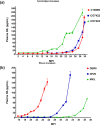Abnormal prion protein, infectivity and neurofilament light-chain in blood of macaques with experimental variant Creutzfeldt-Jakob disease
- PMID: 35816369
- PMCID: PMC10027005
- DOI: 10.1099/jgv.0.001764
Abnormal prion protein, infectivity and neurofilament light-chain in blood of macaques with experimental variant Creutzfeldt-Jakob disease
Abstract
Transmissible spongiform encephalopathies (TSEs) are fatal neurodegenerative infections. Variant Creutzfeldt-Jakob disease (vCJD) and sporadic CJD (sCJD) are human TSEs that, in rare cases, have been transmitted by human-derived therapeutic products. There is a need for a blood test to detect infected donors, identify infected individuals in families with TSEs and monitor progression of disease in patients, especially during clinical trials. We prepared panels of blood from cynomolgus and rhesus macaques experimentally infected with vCJD, as a surrogate for human blood, to support assay development. We detected abnormal prion protein (PrPTSE) in those blood samples using the protein misfolding cyclic amplification (PMCA) assay. PrPTSE first appeared in the blood of pre-symptomatic cynomolgus macaques as early as 2 months post-inoculation (mpi). In contrast, PMCA detected PrPTSE much later in the blood of two pre-symptomatic rhesus macaques, starting at 19 and 20 mpi, and in one rhesus macaque only when symptomatic, at 38 mpi. Once blood of either species of macaque became PMCA-positive, PrPTSE persisted through terminal illness at relatively constant concentrations. Infectivity in buffy coat samples from terminally ill cynomolgus macaques as well as a sample collected 9 months before clinical onset of disease in one of the macaques was assayed in vCJD-susceptible transgenic mice. The infectivity titres varied from 2.7 to 4.3 infectious doses ml-1. We also screened macaque blood using a four-member panel of biomarkers for neurodegenerative diseases to identify potential non-PrPTSE pre-symptomatic diagnostic markers. Neurofilament light-chain protein (NfL) increased in blood before the onset of clinical vCJD. Cumulatively, these data confirmed that, while PrPTSE is the first marker to appear in blood of vCJD-infected cynomolgus and rhesus macaques, NfL might offer a useful, though less specific, marker for forthcoming neurodegeneration. These studies support the use of macaque blood panels to investigate PrPTSE and other biomarkers to predict onset of CJD in humans.
Keywords: assay; biomarkers; blood; infectivity; macaque; prion.
Conflict of interest statement
The authors declare that there are no conflicts of interest.
Figures





Similar articles
-
Kinetics of Abnormal Prion Protein in Blood of Transgenic Mice Experimentally Infected by Multiple Routes with the Agent of Variant Creutzfeldt-Jakob Disease.Viruses. 2023 Jun 28;15(7):1466. doi: 10.3390/v15071466. Viruses. 2023. PMID: 37515154 Free PMC article.
-
Red-backed vole brain promotes highly efficient in vitro amplification of abnormal prion protein from macaque and human brains infected with variant Creutzfeldt-Jakob disease agent.PLoS One. 2013 Oct 24;8(10):e78710. doi: 10.1371/journal.pone.0078710. eCollection 2013. PLoS One. 2013. PMID: 24205298 Free PMC article.
-
Blood reference materials from macaques infected with variant Creutzfeldt-Jakob disease agent.Transfusion. 2015 Feb;55(2):405-12. doi: 10.1111/trf.12841. Epub 2014 Aug 25. Transfusion. 2015. PMID: 25154296
-
PMCA Applications for Prion Detection in Peripheral Tissues of Patients with Variant Creutzfeldt-Jakob Disease.Biomolecules. 2020 Mar 5;10(3):405. doi: 10.3390/biom10030405. Biomolecules. 2020. PMID: 32151109 Free PMC article. Review.
-
Prion protein amplification techniques.Handb Clin Neurol. 2018;153:357-370. doi: 10.1016/B978-0-444-63945-5.00019-2. Handb Clin Neurol. 2018. PMID: 29887145 Review.
Cited by
-
Kinetics of Abnormal Prion Protein in Blood of Transgenic Mice Experimentally Infected by Multiple Routes with the Agent of Variant Creutzfeldt-Jakob Disease.Viruses. 2023 Jun 28;15(7):1466. doi: 10.3390/v15071466. Viruses. 2023. PMID: 37515154 Free PMC article.
References
Publication types
MeSH terms
Substances
LinkOut - more resources
Full Text Sources
Medical
Research Materials

